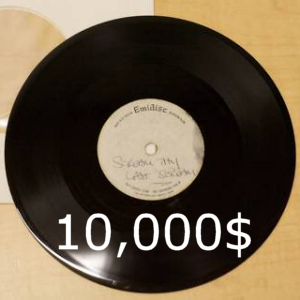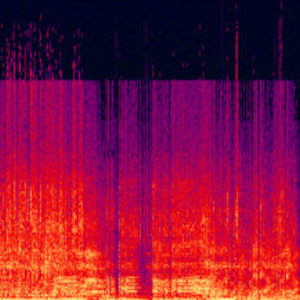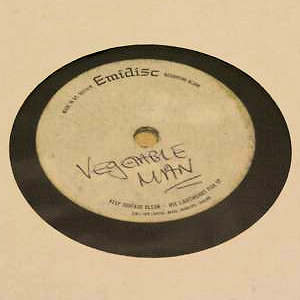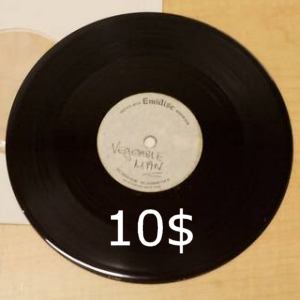2011-02-09
Scream Thy False Scream


What you see at the left is the only remaining copy in the world of an
unreleased 1967 Pink Floyd single: Vegetable
Man / Scream
Thy Last Scream.
Approximate value: 10,000 US dollars,
even on a rainy day.
Part one: Holy Syd!
The songs are on an acetate disc and without going too much into detail we can simply say that an acetate is a test pressing of a vinyl record. An acetate has not been made to last and every time a needle reads the groove the acetate is gradually but irrecoverably damaged. Bands and producers often used acetates to test how a record would sound on cheap home record players before sending the master tape to the record factory.
This precious copy is in the hands of Saq, an American collector in Los Angeles who acquired it about 15 years ago and has cherished it ever since. It is, without doubt, what collectors call a 'holy grail': a rare, valuable object sought after by other collectors. One of the side effects of a 'holy grail' is that it can only acquire that status if other collectors are aware of its existence, but not too many. If nobody knows you have an exclusive item it might as well not exist. Syd Barrett already acknowledged this in his Arnold Layne song: it 'takes two to know'.
Holy grails can be frail, especially when they only consist of audio material. One popular Pink Floyd holy grail are, sorry: were, the so-called work in progress tapes of The Wall (most people, websites and bootlegs refer to these as The Wall demos, which they are clearly not, but that is an entirely different discussion). Around 1999 they circulated amongst top-notch collectors and were generally unknown to the public, The Anchor included, until a track called The Doctor (an early version of Comfortably Numb) was leaked as an alt.music.pink-floyd Christmas 2000 gift. It didn't take long before the complete set was weeded to the fans, who were happy to say the least except for the one of the few who had lost their priceless treasure.
Part two: the guns of Navarro
When Barrett fan Giuliano Navarro met Saq in 2009 he was let on the secret and from this moment Giuliano became a man with a mission. He received pictures of the acetate and finally, on the 15th of January 2011, he proudly announced at Late Night:
I tried to stay in communication with him for more than a year and begged him to at least have the tracks recorded. He agreed to do me the favour, and sent the acetate to a professional studio in San Francisco. (...)
After more than a year of waiting, I finally got the tracks and now I want to share them with all of you. We are the real Syd Barrett crazies and we all deserve to listen to his art. There should be no discovery made that ends up back in the vaults.
Giuliano Navarro is, without doubt, a man of honour. But it helped that
Saq didn't really ran the risk that making the content public would ruin
his holy grail (as with The Wall WIP tapes). Quite the contrary:
he
still has an ultra-rare acetate from 1967;
is envied by collectors
from over the world and, knowing that;
the value of this unique
recording can only sky-rocket.
At least that is what he thought until about a couple of weeks ago.
Part three: cracks in the ice
An uproarious bigmouth called Felix Atagong, who also goes by the ridiculous epithet Reverend of the Holy Church of Iggy the Inuit, proposed Giuliano to upload the sound files to Yeeshkul. At first the recordings were received with great enthusiasm, but after some days the place was stirring with comments of an entirely different nature.
Yeeshkul is a place where Pink Floyd audio collectors meet and share files through a torrent network. They vary from the average je-ne-sais-quoi fan to the specialised sound freak who has the means and the knowledge to find out whether a certain audio file comes from an earlier or a later generation tape. And obviously this spectacular find was going to be analysed to the bit...
Navarro received MP3 files taken from the acetate and shared these immediately with the fans. Not unusual as MP3 is about the most popular sound format in the world, but it does compress the sound and reduces the quality. The Yeeshkul specialist sound brigade argue that lossless files in 24/96 (or even 24/192) should exist as well. Nobody will be that stupid to put an ultra-rare (and very fragile) acetate on a turntable, only to convert the audio to MP3.

Vince666 did a spectrum analysis of the MP3 files and found that the sound had been mysteriously cut-off at 16 Khz (see left side image). Some members maintain that this is a typical result of MP3 compression, but others disagree. But despite the compression and the obvious quality-loss these mono tracks still sound a lot better than other versions that have been circulating for decades.
Felixstrange (no relative to the Church) discovered 'something which sounds a lot like tape damage at 0:54 during "Scream Thy Last Scream':
The noise a minute into STLS is definitely a result of creases in magnetic tape. However, there is definitely vinyl/acetate surface noise present. I've been doing a lot of vinyl rips lately and I immediately recognized the all-too-familiar clicks of debris in the grooves of a record.
Question: How can a brand new, original EMI master show tape
damage, before it has even been used to make vinyl records out of it?
Answer:
It can't.
Part four: screaming vegetables
Vegetable Man and Scream Thy Last Scream (let's shorten that to VM and STLS, shall we?) are both unreleased Syd Barrett - Pink Floyd gems from 1967. EMI has been tempted to put these on compilations before, but for different (copyright) reasons that never happened, luckily two different mixes have leaked to the public.
When (The) Dark Side Of The Moon proved successful EMI compiled early Floyd as A Nice Pair and put the two Barrett solo-albums together in a Syd Barrett budget release. The selling figures (especially in the USA where the solo albums had never been released) were important enough for EMI to beg for a third Syd Barrett solo album. Producer Peter Jenner soon found out that Syd Barrett really wasn't in the singing mood and scraped the barrel in order to find some unreleased material.
On the 13th of August 1974 Peter Jenner (with a little help from John Leckie and Pat Stapley) mixed a stereo tape of unreleased Syd Barrett and Pink Floyd originals, including VM and STLS. This tape, with reference 6604Z, almost immediately evaporated from the EMI archives and re-materialised – so goes the legend – miraculously in one of Bernard White's cupboards.
Almost day by day thirteen years later, Malcolm Jones compiled his personal 'Syd Barratt (sic) Rough Mixes'. It is believed that he accidentally lost this tape just when he was passing by the front door of an anonymous bootlegger.
Part five: check your sources
The Anchor needs to get a bit nerdy and technical here, like those Bible scholars who combine different fourth century Greek editions in order to reconstruct the ultimate Bible source. We are going to compare the different versions of the tracks, so you have been warned.
Barrett fans have strong reasons to believe that the Malcolm Jones 1987 (mono) tapes are the closest to the original 1967 Pink Floyd recordings. In 1974 Peter Jenner added extra effects, echo and reverb to the mix, most notably on VM, and these are absent on the Malcolm Jones tape. The Malcolm Jones mix of STLS fades out, while Jenner's version ends abruptly with – yet – another sound effect.
That is not all. In the case of Vegetable Man there is even a third mix - the so-called Beechwoods tape. It has survived on tape from a 1969 radio show where Nick Mason opened his Pandora’s box of 1967 outtakes. A fan found it back in 2001 and promptly donated it to Kiloh Smith from Madcaps Laughing.
As the acetate allegedly dates from 1967;
Vegetable Man must
sound like the Beechwoods version, and
Scream Thy Last
Scream must sound like the Malcolm Jones rough mix.
Right?
Wrong.
Part six: listen to the music
Yeeshkul member MOB compared all known versions and came back with the following report.

Vegetable Man:
The acetate mix is mono, but definitely different than the Malcolm Jones mono mix from 1987.
The 1967 acetate mix is also different from the 1967 Beechwoods tape, believed to be the most authentic studio version of the song. On the Beechwoods tape, there is absolutely no echo or reverb during the sentence "Vegetable man where are you" but they are present on the acetate.
The only version with extra echo and reverb is the 1974 stereo mix by Peter Jenner.
MOB concludes:
Actually, if I take the 1974 Jenner stereo mix and convert it to mono, I have the same mix as the "acetate" mix. So to me it seems the current mix is not from 1967 (if it was the case it should be close to the 1967 Beechwoods mix, and it's not), but from 1974.
Maybe the 1974 Jenner versions were copied, traded, with some "mono-ization" in the lineage, then pressed as fake acetates?

Scream Thy Last Scream:
The 1967 acetate mono mix is not the same as the Jones 1987 mono mix (the Jones version fades out during the street noises). Instead of that, on the acetate mix, the street noises end abruptly with an echo effect.
MOB:
Is it pure coincidence that the echo is exactly the same effect as the one used by Jenner during his 1974 mixdown?
Again, if you mono-ize the 1974 Jenner mix, you have the current acetate mix (minus the scratches and tape flaws). Same effects at the same moments.
Part seven: the time-paradox explanation
Of course this all makes sense, especially in a Barrett universe, and the contradiction can easily be explained.
Somewhere in 1967 Barrett invented a time-travelling device by combining a clock with a washing machine. When asked to compose a third single he hopped to 1974, stole tape number 6604Z from the EMI archives and returned to 1967.
Thus it is perfectly logical that the 1967 acetate sounds exactly like the 1974 Jenner mix and en passant we have solved the mystery how the tape has disappeared from the EMI vaults.
The utterly boring explanation is that the 1967 acetate is fake, counterfeit, a forgery, made by a scrupulous thief to rob a few thousands of dollars from a collector’s pocket. In other words: mono-ization turned into monetisation.
Part eight: let's get physical
The Anchor is like one of those boring Roger Waters songs: once we're in a drive, we can't stop and we have to make extra parts of the same monotonous melody over and over again.
Even without listening to the counterfeit acetate there still is something dubious about it (thanks neonknight, emmapeelfan,...).
Due to their production process and their fragility acetates are - most of the time - single sided, just like the surviving acetates of Arnold Layne and See Emily Play. Albums were even issued on two different single sided acetates to avoid further damage (but some double sided acetates do exist, like the very first Pink Floyd recording with Bob Klose in the band: Lucy Leave / King Bee [but that was definitely not an EMI acetate]);
Engineers at EMI were invariably nerdy administrative types, who attended recording sessions dressed in white lab coats. These cheeky little fellows would never label an acetate without putting the name of the band on top;
Although a pretty fair forgery the label on the record is not identical to the 'official' EMI acetate label, there also seem to be some glue marks that are usually not present on real acetates;
and last but not least;
Acetates are ad hoc test pressings and in the extremely rare case of a double acetate this means that a certain relationship has to exist between both tracks, like both sides from a single or takes from the same session. STLS was recorded on 7 August 1967 (some overdubs were made in December 1967 and January 1968 for a possible inclusion on A Saucerful of Secrets). VM was recorded between 9 and 12 October 1967. They were never meant to be each other's flip side on a single, so finding them on the same acetate simply makes no sense, unless it is a fake, of course.
Part nine: a spoonful of charades
So basically here is what happened:
1. someone, somewhere in summertime, got hold of the Peter Jenner 1974 stereo-mixes of VM and STLS (not that weird as they have been circulating for at least 3 decades);
2. these were copied on a tape (perhaps even a cassette for home entertainment) but unfortunately it was damaged, trampled, eaten and vomited out by the player (crumpled sound between 51 and 55 seconds);
3. this cassette was downgraded from stereo to mono;
4. the mono 'remaster' was cut on acetate, a fake EMI label was glued on it, and sold to a collector (probably in the mid Nineties);
5. the acetate, believed to be genuine by its owner, was copied in a professional studio to (hopefully) a lossless digital format (there are vinyl record clicks to prove that);
6. the digital copy was then converted to MP3 (with a compression cut off at 16 Khz) and torrented through Yeeshkul.
Part ten: let's add some extra confusion
It has now been established that the 1967 acetate is fake and a mere mono copy of the 1974 stereo mix, but there is still some confusion and a bit of hope.
Although a copy from a copy from a copy the acetate sounds better, crispier and fuller than the Jenner mixes that are currently circulating. To put it into technical gobbledygook: the forger has a better sounding, earlier generation tape at his disposal than the one that Barrett collectors have now. This is something what duly pisses most Syd anoraks off.
Instead of sharing the tape to the fans it has been used to produce bootleg acetates. One can assume that the criminal sold more than one unique acetate, so there must be other collectors around who have purchased this record, believing they had the only copy in the world.
The high-priced acetate market is not that big. Perhaps if we stick together, we can trace the seller who must now tremble like a leaf, and before cutting off his balls and roasting them on a fire, confiscate the low generation tape and use it for the better.

Part eleven: last words
What you see at the left is an acetate counterfeit of a nonexistent 1967
Pink Floyd single
Vegetable Man / Scream Thy Last Scream.
Approximate
value: 10 US dollars, not a cent more.
Let us be fair: not all is lost for Saq, the current owner.
The Anchor has got an excellent business relationship with Fine Art Auctioneers & Valuers Bonhams. For a small 35% commission rate the Anchor is willing to put the acetate on sale at Bonhams as they already have a habit of selling overcharged fake Barrett memorabilia: Bonhams Sells Fake Barrett Poem.
The Anchor wishes to thank: Saquib Rasheed, Giuliano Navarro, Hallucalation, Vince666, Felixstrange, MOB, Neonknight, Emmapeelfan and the other participants at Late Night and Yeeshkul.
Late Night forum thread: Vegetable
Man / Scream Thy Last Scream (Acetate Recordings)
Yeeshkul forum
thread: Pink Floyd - "Vegetable
Man / Scream Thy Last Scream" from rare acetate, 1967 (members only)
The Anchor is the Holy Church of Iggy the Inuit's satirical
division, intended for people with a good heart, but a rather bad
character.
More info: The
Anchor.
Read our legal stuff: Legal
Stuff.

